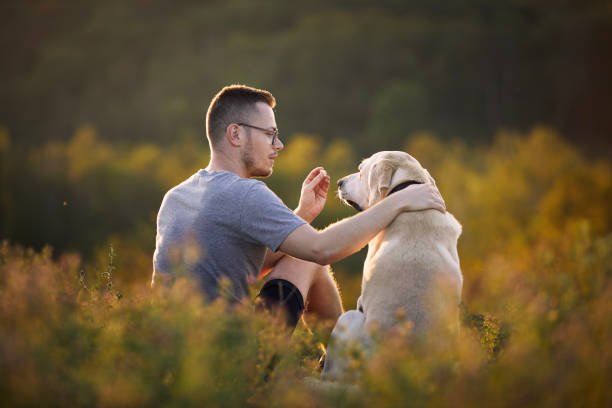Training your dog to stay calm in stressful situations is one of the most valuable skills you can teach. Whether it’s loud noises like fireworks, trips to the vet, or meeting new people, dogs often react with anxiety, fear, or aggression when they feel stressed. This not only affects their well-being but can also create challenging situations for owners.
The good news is that with the right approach and patience, you can teach your dog how to remain composed under pressure. In this article, we’ll discuss proven methods to train your dog to stay calm, helping you and your furry friend navigate stressful moments more easily.
1. Understanding Your Dog’s Stress Triggers
The first step in training your dog to stay calm is identifying the specific situations that cause stress. Every dog has unique triggers, but common ones include:
- Loud noises such as thunderstorms, fireworks, or vacuum cleaners
- Car rides or traveling
- New environments or unfamiliar places
- Meeting strangers or other animals
- Veterinary visits or grooming sessions
Once you’ve identified these triggers, you can focus on desensitizing your dog to these stressors and introducing positive experiences.

2. Desensitization and Counterconditioning
Desensitization is the process of gradually exposing your dog to their stress triggers at a low intensity, while counterconditioning involves pairing the stressor with something positive, such as treats or affection.
Here’s how to implement these techniques:
- Start Small: Begin by exposing your dog to a mild version of the stressor. For example, if your dog is scared of fireworks, start by playing a soft recording of fireworks sounds at a low volume.
- Stay Positive: While the stressor is present, reward your dog with high-value treats or play with their favorite toy. The goal is to create a positive association with the previously stressful situation.
- Gradually Increase Exposure: Over time, increase the intensity or duration of the exposure. Continue to offer rewards as your dog remains calm. If they start to show signs of anxiety, take a step back and lower the intensity.
By repeating this process, you can help your dog become desensitized to the stressful stimuli and eventually stay calm even in the real-life situations that used to cause anxiety.
3. Teach Relaxation Cues
Another key strategy in training your dog to remain calm is teaching them relaxation cues. These commands, like „settle“ or „relax,“ can signal to your dog that it’s time to be calm. Here’s how to do it:
- Create a Calm Environment: Start training in a quiet place with no distractions. Have your dog lie down and reward them when they remain in a relaxed state.
- Introduce the Cue: Once your dog is lying down and relaxed, say your chosen command, such as „settle“ or „relax.“ Repeat this process, and over time, your dog will associate the word with the act of calming down.
- Practice in Different Situations: Once your dog has mastered the cue in a calm setting, gradually introduce mild stressors, like someone ringing the doorbell. When your dog becomes excited or anxious, give the cue and reward them when they settle down.
The goal is to condition your dog to relax on command, even when they are feeling stressed. This gives you a powerful tool to help them stay calm in high-pressure situations.
4. Practice Positive Reinforcement Training
Positive reinforcement training is a crucial part of helping your dog stay calm in stressful situations. This method involves rewarding desired behaviors rather than punishing unwanted ones. Here’s how it works:
- Identify Desired Behavior: Focus on the behavior you want to see, such as sitting calmly during a car ride or lying down when guests arrive.
- Reward Good Behavior: Whenever your dog remains calm during a stressful event, immediately reward them with treats, praise, or toys. This teaches them that staying calm brings positive rewards.
- Ignore Unwanted Behavior: If your dog reacts negatively, such as barking or pacing, avoid scolding them. Instead, remain calm yourself and wait for them to settle before offering any attention or reward.
Positive reinforcement not only teaches your dog to remain calm but also strengthens your bond with them, creating a relationship built on trust and understanding.
5. Use Calming Tools and Aids
In some cases, using calming tools or aids can help your dog relax, especially in situations where they’ve previously struggled. These tools can be used alongside training to create a calm environment. Some options include:
- Calming vests or wraps: These snug-fitting garments, such as the Thundershirt, provide gentle pressure that can help soothe your dog during stressful situations, such as fireworks or thunderstorms.
- Calming music or white noise: Playing soft, calming music or white noise can help mask stressful sounds like construction or fireworks. Music has been shown to have a relaxing effect on dogs, reducing anxiety.
- Aromatherapy: Certain scents, such as lavender, can have a calming effect on dogs. You can use pet-safe essential oils in a diffuser to create a relaxing atmosphere.
- Pheromone sprays or diffusers: Products like Adaptil, which mimic calming dog pheromones, can help reduce stress in certain situations. These can be especially helpful during travel or when introducing your dog to new environments.
While these tools won’t replace training, they can be valuable aids in helping your dog remain calm in otherwise stressful situations.
6. Stay Calm and Confident
Dogs are highly attuned to their owners’ emotions. If you’re anxious or stressed, your dog is more likely to feel the same way. When approaching a stressful situation, such as a trip to the vet, remain calm, confident, and reassuring. Speak to your dog in a soothing voice, avoid showing frustration, and maintain a relaxed posture.
By staying calm yourself, you send a clear signal to your dog that there’s nothing to fear. Over time, your dog will learn to mirror your calm behavior in stressful situations.
7. Be Patient and Consistent
Training your dog to stay calm in stressful situations takes time and consistency. Some dogs may learn quickly, while others need more patience and practice. Keep your training sessions short and positive, and never force your dog into situations they are not ready to handle. If you’re consistent with your approach and patient with your dog’s progress, you’ll start to see improvement.
If your dog has severe anxiety that doesn’t improve with training, consider consulting a professional dog behaviorist or veterinarian for further guidance. In some cases, anxiety-reducing medications may be necessary alongside training.
Conclusion
Training your dog to remain calm in stressful situations is an investment in their emotional well-being and your overall relationship. By understanding their stress triggers, using techniques like desensitization and counterconditioning, and reinforcing positive behavior, you can help your dog feel more relaxed in high-pressure moments.
Remember, staying patient, consistent and using calming tools when needed will set both you and your dog up for success. With time and practice, your dog will develop the confidence and composure to handle stressful situations with calm and ease.




